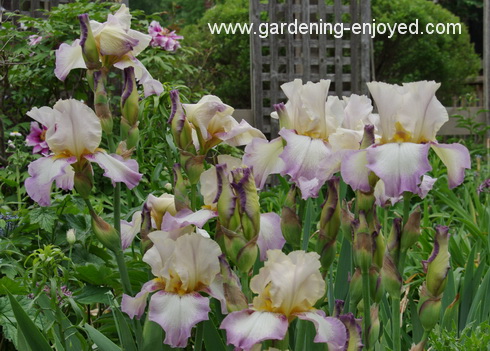
All of my heavens have come together! The Iris are blooming. Yes, it is my favourite flower and each day a new one pops open and each day that one becomes my favourite. I cut a bunch for the house because even the Assistant Gardener admires them. As I walk around each morning I check to make sure that I don’t have any duplicates because they would be taking up space that I might be able to use for another new variety. I also have to put a marker beside the ones that are getting a bit old or large and will need to be dug and divided by mid summer. The smaller Iris have been blooming all over the garden for a few weeks but the tall bearded ones are what I really wait for. The picture is Cinnamon Girl and as you can see she is a big clump with multiple flowers. She is taking up more than her share of that bed but I’m not sure I can bring myself to break
her up since she has no open or dead sections, just masses of bloom. That’s a decision for later.
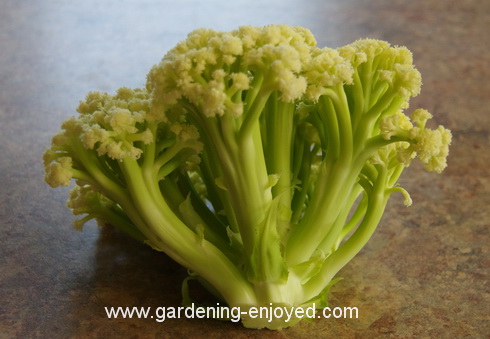
This is last night’s dinner. It’s a new vegetable for me, known as Sprouting Cauliflower. It produces a head of Cauliflower weeks before the regular varieties and as you can see it starts to open up and create individual little heads. I will let one of the next heads continue to open a little longer to see what eventually happens. Several florets were cut off and steamed lightly until just tender then served with a sprinkling of grated Parmesan. Quite delicious. I have been tying the leaves over the developing heads to help retain their light colour; the sun will tend to green them. The seed came from Agrohaitai an Ontario supplier of many types of oriental vegetable seeds. There are a few more developing rather quickly, it’s a good thing that Cauliflower is the Assistant Gardener’s favourite vegetable.
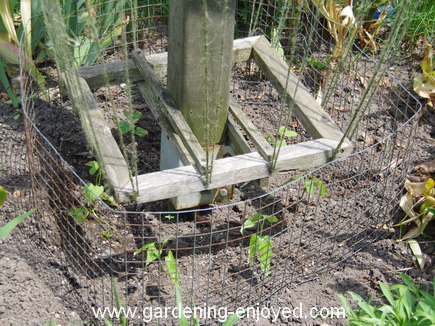
This is the base of my string trellis that supports the Morning Glories and Pole Beans. The Morning Glories are started indoors and have just been planted around the bottom of the trellis and in between those plants are the seeds of four different Pole Beans. Two on this trellis and the other two on its neighbour. The trick to starting Morning Glories inside is not to be too early. Another week after what you see here and the plants would have started to twist around each other becoming a nightmare to untangle. The little fence around the space is a rabbit fence and one of the challenges is to make sure the Morning Gloriy tendrils find the string rather than the fence.
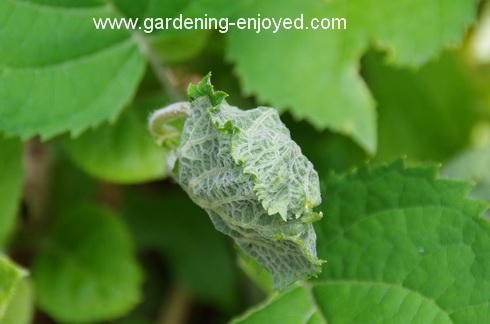
Hydrangea arborescens, produces some amazingly large heads by mid-summer but right now you might find something like this. The two top leaves are stitched together to make a home for the Hydrangea leaftier, Olethreutes ferriferana, which lays its eggs on the leaves and the larva that hatch do this rather neat stitching job so that they can munch away on the, now enclosed, flower buds undisturbed by any predators. The only viable treatment is to gently pry those leaves apart and crush the caterpillar. The plant will then carry on growing and eventually flower. That caterpillar will eventually fall to the soil and spend the rest of the summer and the winter as a pupa, emerging as the adult in the spring to lay new eggs. It’s a bit of a tedious chore but it can be rather satisfying as you do your search and destroy mission.
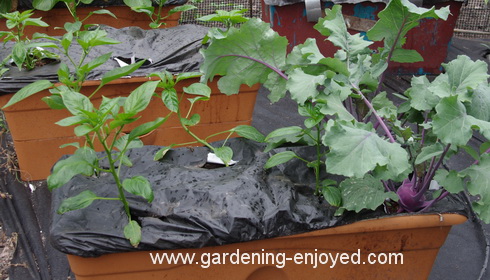
This Earthbox is in transition. It easily produces at least two crops per year and you can see the last of the Kohl Rabi at the right end and the recently planted Sweet Peppers in the other spaces. The box did not get any treatment or additional fertilizer, I just teased out the root of the Kohl Rabbi and put the Pepper plant in its place. The other two Kohl Rabi will depart for the dinner table soon leaving the whole box to support the four Pepper plants. In a perfect world the Peppers might leave by mid September and be replaced by some fall lettuce or similar quick cool crop.
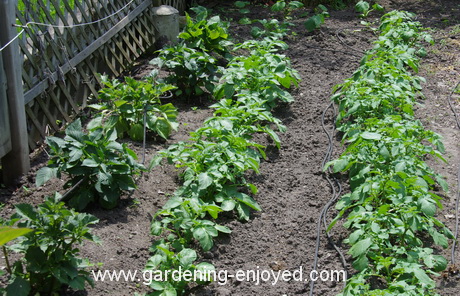 This is another experiment in crop maximization. All America Selections sent me some seeds of Blue Prince Pumpkin one of this year’s award winners. I don’t usually grow Pumpkins mostly due to lack of space but this one is apparently very edible as well as quite decorative. The picture shows my two rows of Potatoes and if you look closely you can see the baby Pumpkin plant at the end between the rows; there is another one at the near end. The idea is to restrict the pumpkins to one or two vines each and train those vines to grow down the gap between the Potato rows. If that wasn’t a crazy enough idea I have planted seeds for my Okra down that same space thinking that it will grow tall and out of the way of the Pumpkins. Stay tuned! The big leafy plants to the left are my Dahlias and I have no idea how I’m going to get to them to cut
their blooms for the house. I really must listen to the Assistant Gardener and cut back a little but inquiring minds want to know more than an aging body wants to do.
This is another experiment in crop maximization. All America Selections sent me some seeds of Blue Prince Pumpkin one of this year’s award winners. I don’t usually grow Pumpkins mostly due to lack of space but this one is apparently very edible as well as quite decorative. The picture shows my two rows of Potatoes and if you look closely you can see the baby Pumpkin plant at the end between the rows; there is another one at the near end. The idea is to restrict the pumpkins to one or two vines each and train those vines to grow down the gap between the Potato rows. If that wasn’t a crazy enough idea I have planted seeds for my Okra down that same space thinking that it will grow tall and out of the way of the Pumpkins. Stay tuned! The big leafy plants to the left are my Dahlias and I have no idea how I’m going to get to them to cut
their blooms for the house. I really must listen to the Assistant Gardener and cut back a little but inquiring minds want to know more than an aging body wants to do.
To ask a question just “reply” to this ezine. Don’t forget to check the front page of the Website for frequent short ideas for current gardening activities.
Dan Asks? As I plant my zucchini and summer squash I'm wondering what I can do now to eliminate squash borers. I've tried excessive rototilling, changing plant locations and even changing the soil. None of these changes has eliminated the problem. Come late summer when I start to harvest the borers appear and destroy my plants. Any suggestions.
Ken Answers!I suffer from the same problem and this year I am going to try wrapping the lower portions of the stems,before or just after I plant them with a cover of aluminum foil to prevent the
larva from entering. The adult apparently lays eggs in the soil near the plants and the emerging larva cross the soil and move in.
Linda Asks? I was all set to water my tomato seedlings with Epsom salts until I read a review that cautioned against it. What is your opinion?
Ken Answers!Epsom salts is magnesium and that's rarely needed in most soils, It's calcium the Tomatoes would appreciate. Powdered milk works.
Sandy Asks? We've just moved, and I have a small collection of Chapman irises at the old place, which has not yet sold. If it sells before summer, is it worthwhile trying to bring the irises over to the new garden? After I asked you, I thought to ask Chapman himself and here is his answer.
Ken Answers! I agree with Chuck who said:
Yes, it you dig clumps with dirt. Another possibility is put in as condition of sale, that you can remove iris in August. Make it that you leave most, but take a
proportion, but not all of any clump.
|

 This is another experiment in crop maximization. All America Selections sent me some seeds of Blue Prince Pumpkin one of this year’s award winners. I don’t usually grow Pumpkins mostly due to lack of space but this one is apparently very edible as well as quite decorative. The picture shows my two rows of Potatoes and if you look closely you can see the baby Pumpkin plant at the end between the rows; there is another one at the near end. The idea is to restrict the pumpkins to one or two vines each and train those vines to grow down the gap between the Potato rows. If that wasn’t a crazy enough idea I have planted seeds for my Okra down that same space thinking that it will grow tall and out of the way of the Pumpkins. Stay tuned! The big leafy plants to the left are my Dahlias and I have no idea how I’m going to get to them to cut
their blooms for the house. I really must listen to the Assistant Gardener and cut back a little but inquiring minds want to know more than an aging body wants to do.
This is another experiment in crop maximization. All America Selections sent me some seeds of Blue Prince Pumpkin one of this year’s award winners. I don’t usually grow Pumpkins mostly due to lack of space but this one is apparently very edible as well as quite decorative. The picture shows my two rows of Potatoes and if you look closely you can see the baby Pumpkin plant at the end between the rows; there is another one at the near end. The idea is to restrict the pumpkins to one or two vines each and train those vines to grow down the gap between the Potato rows. If that wasn’t a crazy enough idea I have planted seeds for my Okra down that same space thinking that it will grow tall and out of the way of the Pumpkins. Stay tuned! The big leafy plants to the left are my Dahlias and I have no idea how I’m going to get to them to cut
their blooms for the house. I really must listen to the Assistant Gardener and cut back a little but inquiring minds want to know more than an aging body wants to do. 



